To the south of 86th Street in Southwest Philadelphia’s Eastwick neighborhood you can’t drive more than a few yards on the cross streets before you run into concrete barriers.
“We had them put up the barricades since they would pull back in the cul-de-sac and dump,” says Leonard Stewart, a longtime Eastwick resident and community activist, referring to the 135 meters of Gibson Street that extend beyond the barrier until the street dead-ends into vacant greenspace. In 2018, responding to years of complaints from the residents who live on the residential blocks to the north, the City set up the barriers. “Before, there used to be trash all the way back in the cul-de-sac. And trying to get the City to clean it up you’d be calling and calling and calling them.” Now the dumping is confined to a smaller space in front of the barriers or, as was apparent on a tour of the neighborhood’s dumping hotspots, just on the other side.
Scattered wooden posts, presumably from a dismantled fence, a sofa, car tires and one enormous tire that would have looked at home on an earthmover sat in front of the barrier at Gibson Street. Just behind the barrier a pile of broken asphalt, bundles of old wooden slats and scattered contractor bags waited for a City cleanup.
At the end of Cratin Place the heap of trash seemed to have once been the contents of an apartment: a sofa, a mattress, a beat-up door and a ripped-out carpet.
“This is an old problem,” says Ramona Rousseau-Reed, the vice president of Eastwick Friends & Neighbors Coalition, who, along with Stewart, took Grid on a tour of dumping hotspots. She said that, once, at the Heinz Wildlife Refuge’s office, she had the chance to go through archived newspaper clippings, including some from the 1960s. “They had pictures in there of people picketing, and it was all about dumping.”
They know what they’re doing. They dump it and get back on 95.”
— Leonard Stewart, Eastwick resident
The vacant land of Eastwick is a magnet for debris from across the region. At 86th and Luther Place, Stewart recalled the time they ran off a truck with Delaware tags, previously seen dumping by a neighbor. “They know what they’re doing,” Stewart says. “They dump it and get back on 95.”
Eastwick is not unique in suffering from illegal dumping, also called “short dumping.” Neighborhoods across the city bear the burden of piles of tires, construction debris, contents of cleaned-out apartments and even household trash left for someone else to clean up. According to the 2019 Zero Waste and Litter Cabinet Progress Report, Philadelphians called in nearly 40,000 requests for litter or dumping cleanups. In that same year the Streets Department conducted about 4,600 cleanups yielding 6,808 tons of “heavy” (to distinguish it from routine litter) dumped waste. Keep Pennsylvania Beautiful estimates that cleaning up dump sites costs municipalities about $600 per ton, which would put the 2019 total cost at about $4 million.
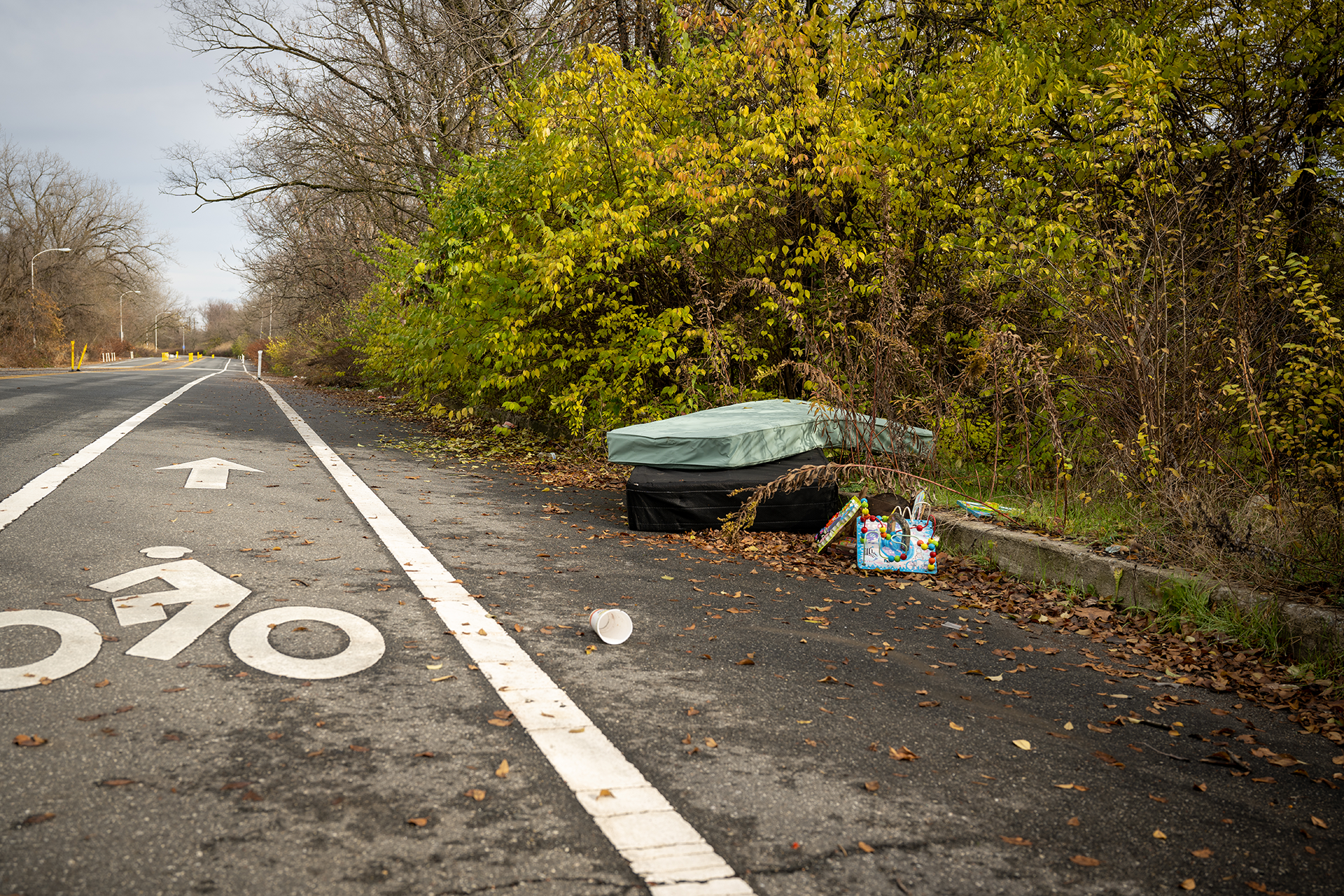
Cleanup can also be costly for Philadelphia businesses. On the 3000 block of Ellsworth, where the road dead-ends in an industrial section of Gray’s Ferry near the Schuylkill River, the energy company Vicinity repeatedly cleans up dumped debris, according to Jessica Hartley, Vicinity’s environmental, health and safety and community relations manager. “We’ve probably filled a 30-yard dumpster three times in the last year cleaning this street up,” she says. “The more recent cleanup we did was quite sad as the waste piles contained tons of a child’s clothes, toys and schoolwork. I think about that kid a lot and hope she is ok.”
Dumping is also a drag on the city’s parks. In Tacony Creek Park the Whitaker Avenue Bridge offers a convenient spot for people hauling waste to pull over and quickly toss their load out of sight. In October a giant pile of tires that had been dumped over the bridge took weeks to be removed through the combined efforts of volunteers and Philadelphia Parks & Recreation work crews, as Grid covered in the December 2022 issue (#163).
It should be no surprise that no one takes a job with the Parks Department to pick up people’s household trash or demolished apartments.”
— Daniel Lawson, former Parks & Recreation sustainability manager
The result is that park maintenance crews spend the majority of their time cleaning up trash, time they could be spending maintaining playing fields, planting trees or fixing up recreation centers. “It should be no surprise that no one takes a job with the Parks Department to pick up people’s household trash or demolished apartments,” says Daniel Lawson, who worked for four and a half years for the department, most recently as the sustainability and quality control manager.
In addition to construction debris, apartment cleanouts and tires, parks are magnets for household trash.
“We were doing a park cleanup, and we were at the other end of the park. We saw a woman come out of the house and bring household garbage bags and chuck them into the park,” says Robin Irizarry, who until the end of 2019 worked for the Tookany/Tacony-Frankford Watershed Partnership, which often conducts park cleanups in Tacony Creek Park.
Other park neighbors will stuff their trash into park trash cans, or leave them next to the bins, avoiding the wait until their usual weekly trash pickup. “In my own neighborhood I’ve seen neighbors walk out across to the park and stuff it into a can where it doesn’t fit,” Lawson says. Food waste can attract rats, raccoons and other animals that tear open bags and then leave their contents strewn across the park, yielding more of a mess for maintenance crews to deal with.
Lawson says that fighting dumping requires an understanding of the distinct reasons people dump different types of waste, a theme of the City’s Zero Waste and Litter Cabinet (ZWLC) in which Lawson participated while he was at Parks & Recreation.
Before the COVID-19 pandemic began in the spring of 2020, ZWLC, launched by Mayor Jim Kenney in 2016, had advanced several policies and initiatives aimed at enforcing anti-dumping laws and tracking often-dumped waste such as construction debris and old tires.
The cabinet developed legislation with City Councilmembers to better keep track of construction debris and tires to deter dumping. Tire dealers now have to apply for a license, in the process selecting a tire hauler from a pre-approved list. Licenses and Inspections (L&I) permits for construction, demolition and alterations are required to list a waste hauler, and both the hauler and the permit holder have to keep records of the waste disposal receipts.
The cabinet also worked with City Council, the Philadelphia Police Department and the District Attorney’s Office to increase penalties for dumping (fines, the seizure of vehicles used in dumping, community service requirements) and improving communication between the Streets Department, law enforcement and prosecutors. In response to feedback from the police department, the cabinet worked with them to create an Environmental Crimes Unit staffed by two detectives focused on dumping. Before the pandemic the City also installed cameras at dumping hotspots and assigned Streets Department staff to review footage.
The work apparently paid off. The 6,808 tons of heavy dumped waste reported in 2019 was a substantial decrease from fiscal year 2016, when Streets cleaned up 11,525 tons of dumped waste.
Unfortunately the pandemic and ensuing disruptions to City government undid much of the progress.
The Kenney administration, seeking to save money, laid off the cabinet’s director, Nic Esposito, in May 2020. (Nic Esposito is Grid’s director of operations.)
Departments critical for the dumping enforcement effort have also seen debilitating staffing crunches. L&I, the department that monitors construction sites in the city, lost a third of its inspectors between 2019 and the beginning of 2022. The Police Department is reportedly 1,300 officers short as it struggles to keep pace with the city’s surge in gun violence.
Placing cameras in hotspots has not always aided enforcement. Reviewing the hours of footage has proven to be a bottleneck, and when a camera does capture an image of a license plate, it takes time and resources to track down the owner and investigate the case.
Enforcement efforts that were not keeping up with the pace of dumping before the pandemic have only fallen further behind since.
In Eastwick, Stewart and Rousseau-Reed have become experts at responding to illegal dumping. They organize neighbors to respond to dumping as quickly as possible, sometimes as it happens. “A lot of times we’ll take the license plate down,” Stewart says. “One time we tracked them down and called the owner [of the company that owned the truck] about it. He came and cleaned it up and said, ‘Please don’t call the police.’ We already did,” he says.
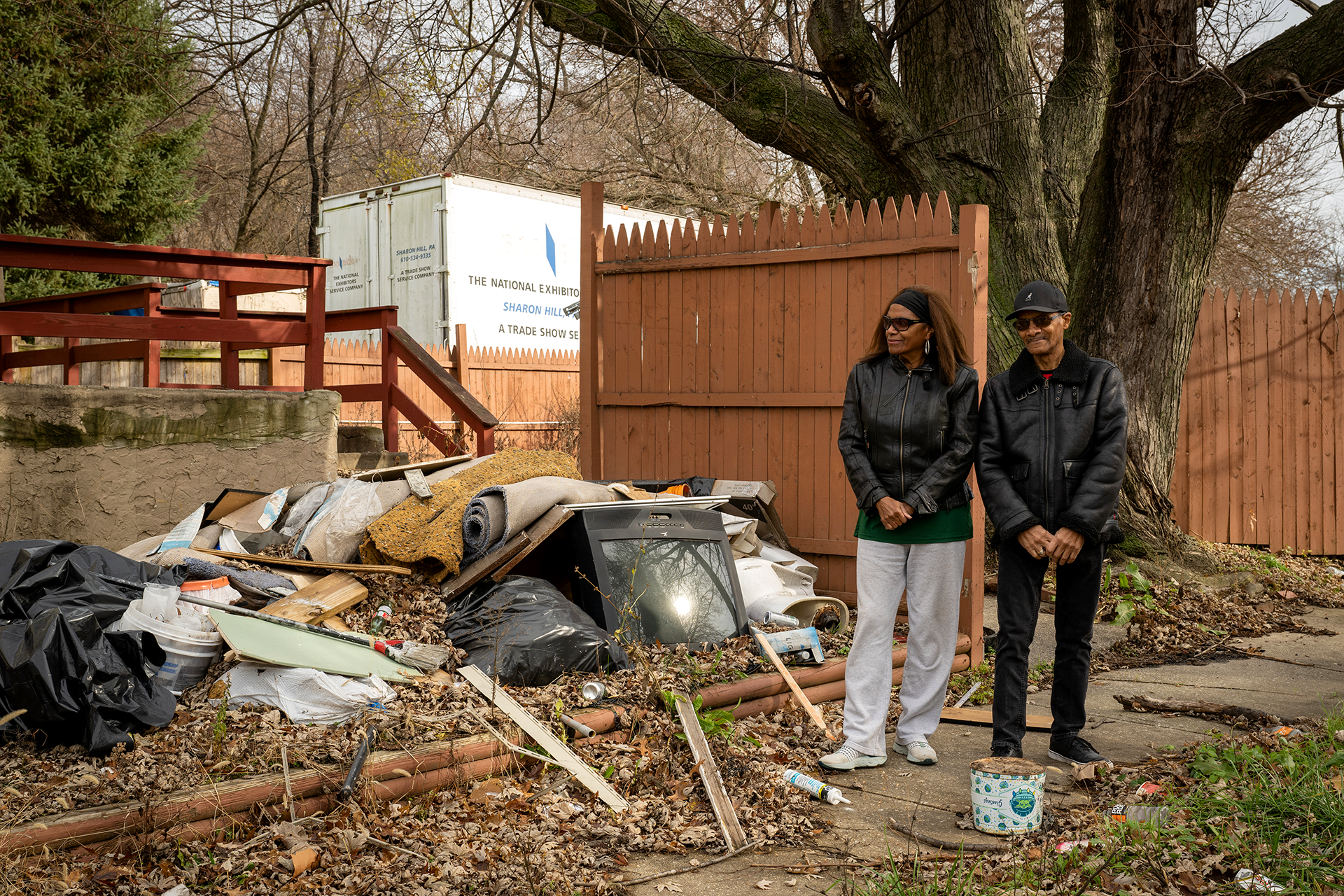
The two organizers don’t know what happens after they relay pictures and license plate numbers of the dumpers to the police, who don’t report back to them. The 12th police district, which includes their neighborhood, is stretched too thin to tackle the dozens of dumping instances residents submit, according to what Stewart and Rousseau-Reed report hearing back from the police. “It’s a low priority when there are shootings on Elmwood Ave.,” Stewart says.
Before 2019 ZWLC provided a venue for staying on top of reported dumping cases and urging police to devote the resources to investigate cases. In the cabinet’s absence it is easier for dumping cases to languish at police districts.
Ultimately someone dumping illegally today has little risk of suffering any consequences. Out of the tens of thousands of dumping reports from Philadelphia residents, the 2019 ZWLC Progress Report noted 351 enforcement cases being tracked, eight defendants referred to the Community Life Improvement Program (CLIP) to serve community service, 153 tickets issued by CLIP, 30 active investigations and 14 cases awaiting trial.
Although neither CLIP nor the Streets Department responded to Grid’s requests for data from after 2019, District Attorney’s Office data show that few dumpers face criminal penalties. After years of single-digit arrests for littering or illegal dumping (lumped together in the statistics), 2019 saw a peak of 23, followed by a drop to 13 in 2020, one in 2021 (possibly reflecting COVID-related court closures) and nine to date in 2022. Charged cases follow a similar trend, with a peak of 26 in 2019 and 17 to date in 2022. Many of those charges end up withdrawn or dismissed. In 2019, 11 people were found guilty or ended up in diversion programs for littering or illegal dumping, five in 2020, and zero in 2021.
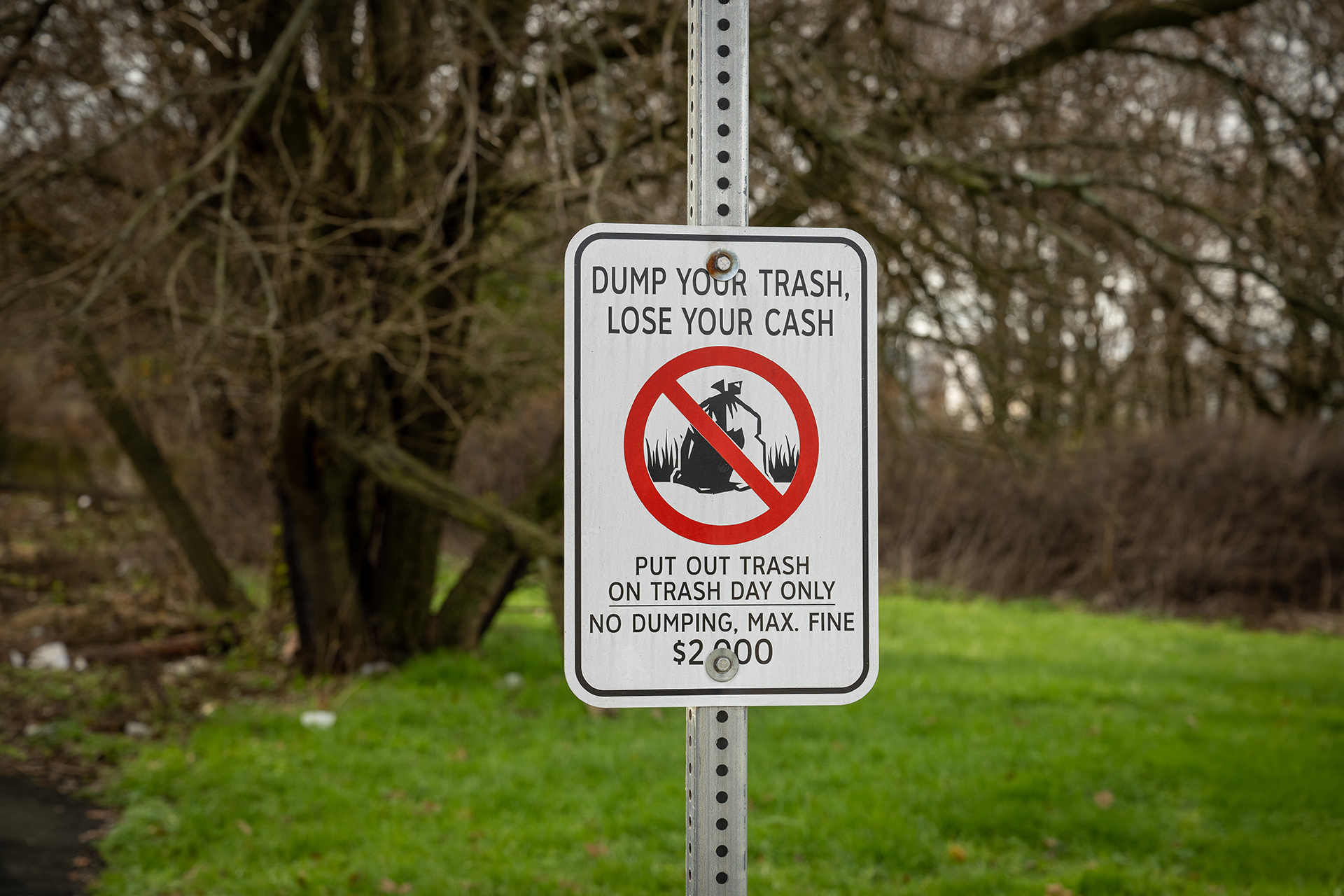
According to a November 2022 Streets Department press release, the Philadelphia Law Department has also begun prosecuting some dumping cases rather than the District Attorney’s Office. In the first such case, an offender caught on camera in North Philadelphia was ultimately ordered to pay $10,700 in fines and cleanup costs.
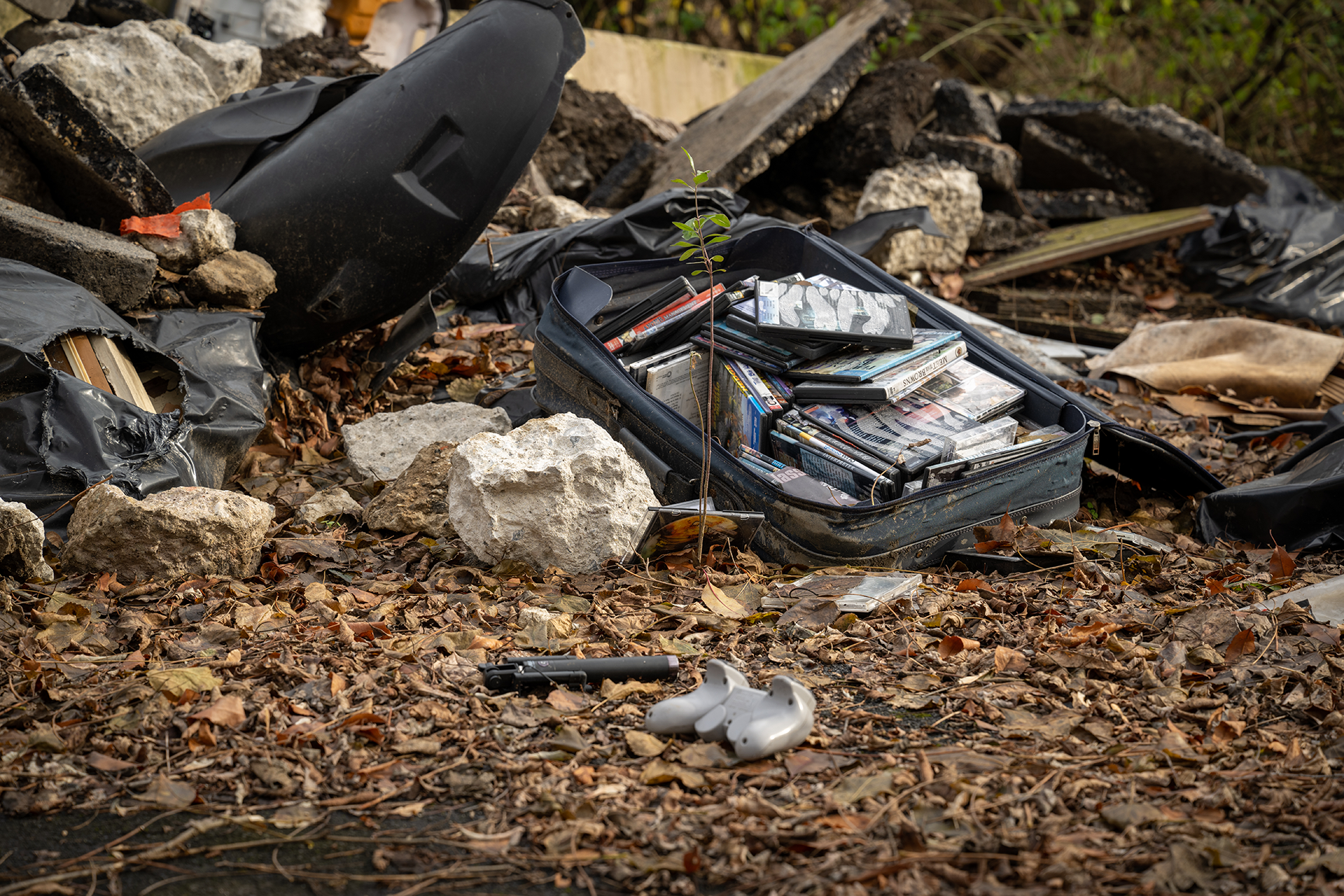
Illegal dumpers push their loads over the edge of the bridge over the railroad tracks on Whitby Avenue at 53rd Street in Southwest Philadelphia. On a visit in early December, what looked like the contents of a small apartment were scattered down the railroad embankment: a couple mattresses, half-open suitcases full of clothing, a toy Captain America shield. On the sidewalk sat a broken bookshelf, large black plastic bags of foil pans and other cooking waste and one white plastic bag full of what appeared to simply be routine, household trash.
It makes me feel frustrated to see areas where I see lots of children walking to school treated as an area for dumping.”
— Derek Rigby, Southwest Philadelphia resident
Derek Rigby, who lives around the corner from the bridge, takes part in cleanups with his neighbors and otherwise does his best to hound the City until they send a crew to clean it up. “We walk past the bridge to take the kids to school, to catch SEPTA, so we regularly will know whether it is clean or not and notice when the City responds to our 311 requests,” he says. If he and his partner keep submitting requests, it takes the City about a month to respond, he says.
“It makes me feel frustrated to see areas where I see lots of children walking to school treated as an area for dumping. And that the City doesn’t respond quickly,” Rigby says. “It also frustrates me that the City doesn’t have a better approach to trash removal and options for people to dump waste.”
The City’s sanitation convenience centers allow residents to dump extra household waste (electronics, yard waste, furniture, etc.) but not construction waste. Commercial dumps charge $100 per ton but don’t offer rates for smaller quantities.
“Where I grew up in Utah you could pay five dollars to dump at the city’s municipal dump,” Rigby says. “As a Philadelphia resident who has done home renovations, the options I have found are the convenience sites, but they don’t receive construction materials. The other options are paying by the ton, which costs a minimum $100 dollars, which is not affordable to do regularly. I see that pattern as to why someone running a construction company or doing a project would choose to dump, because it is much cheaper to dump, and hopefully not get a fine.”
Providing disincentives to dumping, such as fines, will always be necessary, but reducing the barriers to legal waste disposal could also be part of the solution. Circular Philadelphia, a circular economy nonprofit organization founded by Esposito and Samantha Wittchen, has proposed a middle option, in collaboration with Trash Academy and Terrill Haigler (aka “Ya Fav Trashman”), in which the City’s sanitation convenience centers would accept a van or pickup truck load of construction waste for $30. Parks & Recreation’s Fairmount Park Organic Recycling center already offers a similar service for debris such as dead leaves or wood chips. “Even if the $30 fee doesn’t fully cover the total cost of disposal through the construction recycling contract, the difference will be far less than the amount of money the City spends cleaning up illegal dumping,” according to Circular’s policy brief on the proposal.
Lawson says he had some success with signage. Signs posted with an increased fee of $2,000 (up from $300) reduced dumping of commercial waste somewhat. “Seeing an extra zero deterred some people,” he says. “In other neighborhoods people spray painted the sign and kept on dumping, but putting the sign there says the City sees what you’re doing and doesn’t appreciate it.”

Stopping household waste dumping requires a different approach. “It is generally something people don’t consider to be wrong,” Lawson says. “There is a mentality of ‘the City should clean this up.’ If you’re a resident you might not be able to discern between Parks & Recreation and the Streets Department.”
Lawson had some success posting small signs right on the park trash cans, for example in Marconi Plaza in South Philadelphia. The signs showed a cartoon figure warning against dumping. “When we put it on the cans, we mean you, standing there with your household trash in your hands,” he says.
Parks & Recreation also worked with the Streets Department’s SWEEP sanitation enforcement officers. “If we found a park getting chronically hit, we got a SWEEP officer to do targeted enforcement, see which addresses they came from and drop civil enforcement tickets in their mailbox.” The tickets are $50, not nearly as painful as the $2,000 dumping fine, but enough to get a household’s attention.
Rousseau-Reed recently took part in Clean Philadelphia Now, an anti-dumping campaign of Mural Arts’ Trash Academy program. Along with other local anti-dumping activists they studied the causes of dumping and worked to produce a platform of solutions.
Along with continued abatement (cleaning up) of dumping and beefing up enforcement measures, such as by increasing L&I staffing, the draft platform that Grid reviewed in early December recommends allowing small-scale construction waste at convenience centers, in line with Circular’s policy proposal, as well as developing policies to require recycling construction debris.
People who dump waste tend to leave it in spaces that look to be abandoned, like the greenspaces of Eastwick, and the platform advocates beautifying these spaces and inviting the community to activate them by gardening or holding events. In a similar vein, Circular Philadelphia has launched an initiative to advise businesses on how they can utilize neighboring vacant lots.
The platform recommends overhauling household waste collection by, among other measures, automating it. Providing households with standard lidded containers for household waste and recycling that can be tipped into trucks mechanically and, where appropriate, increasing collection to twice a week could give households less of a reason to ditch their trash in a park mid-week.
Good data on littering and dumping are key to developing and implementing solutions, and the platform endorses the restoration of ZWLC or a similar office.
Rousseau-Reed is clear that the work that Stewart, she and other local activists do to chase off dumpers and nag the City to clean up is not a complete solution, but they aren’t waiting for citywide reform to save their neighborhoods from dumping.
Along with other problems of neighborhood neglect, dumping eats away at the pride residents should feel in their homes. “Many neighbors have said to me, ‘I’m embarrassed when I have company,’” Rousseau-Reed says. Much of what the Eastwick activists do depends on restoring their neighbors’ sense of agency.
As the tour wound up, we encountered a neighbor walking her dog on her way into the wildlife refuge. Rousseau-Reed talked with her for 20 minutes about how to organize her block, including an updated version of an old-fashioned phone tree. Whenever one neighbor spots something amiss, the entire block could be notified so that they could all call it in at once. She also talked up the recently launched neighborhood watch and the Eastwick bike patrol, all efforts by the community to take control of their streets. They could only do it together.

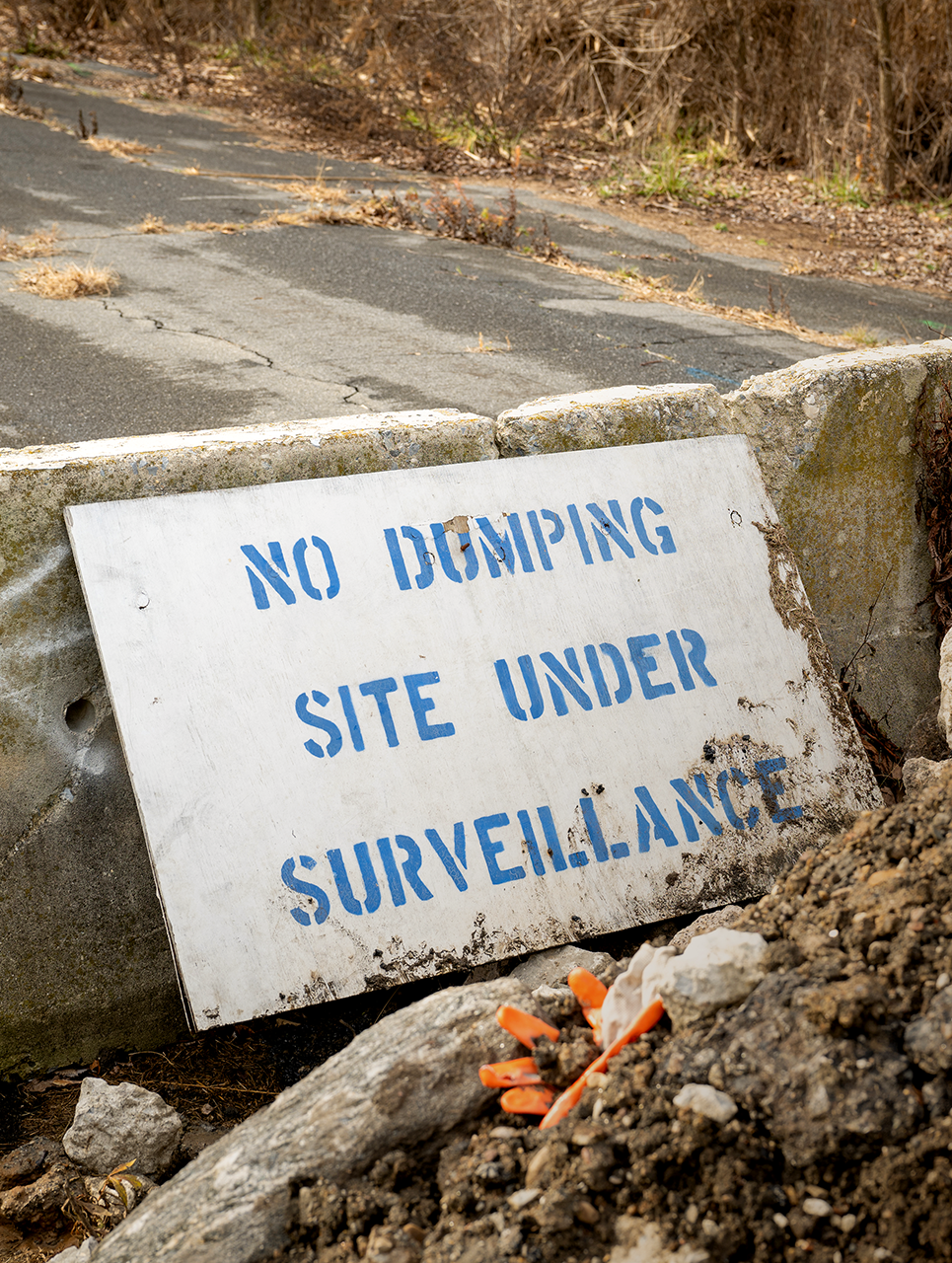

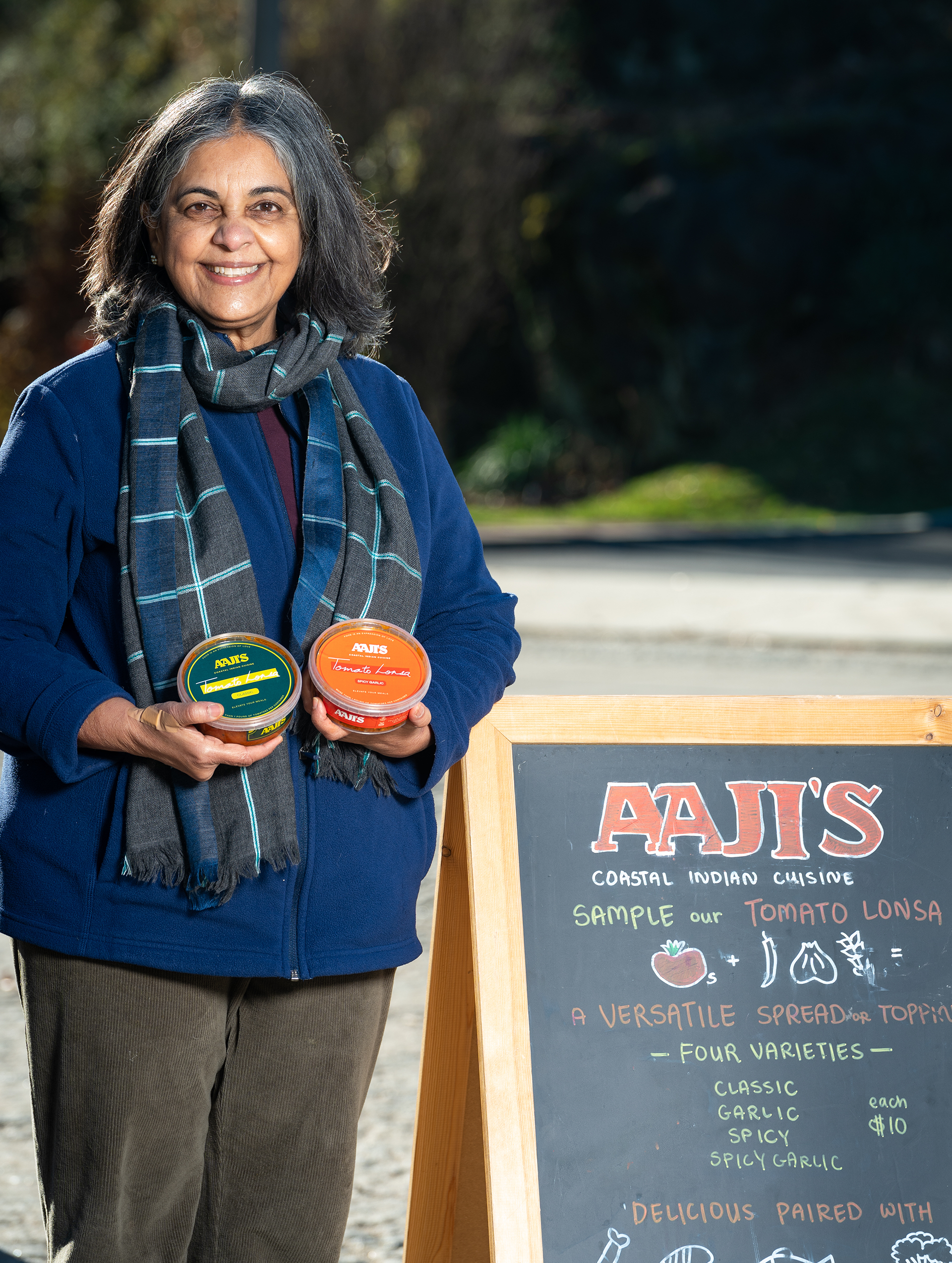



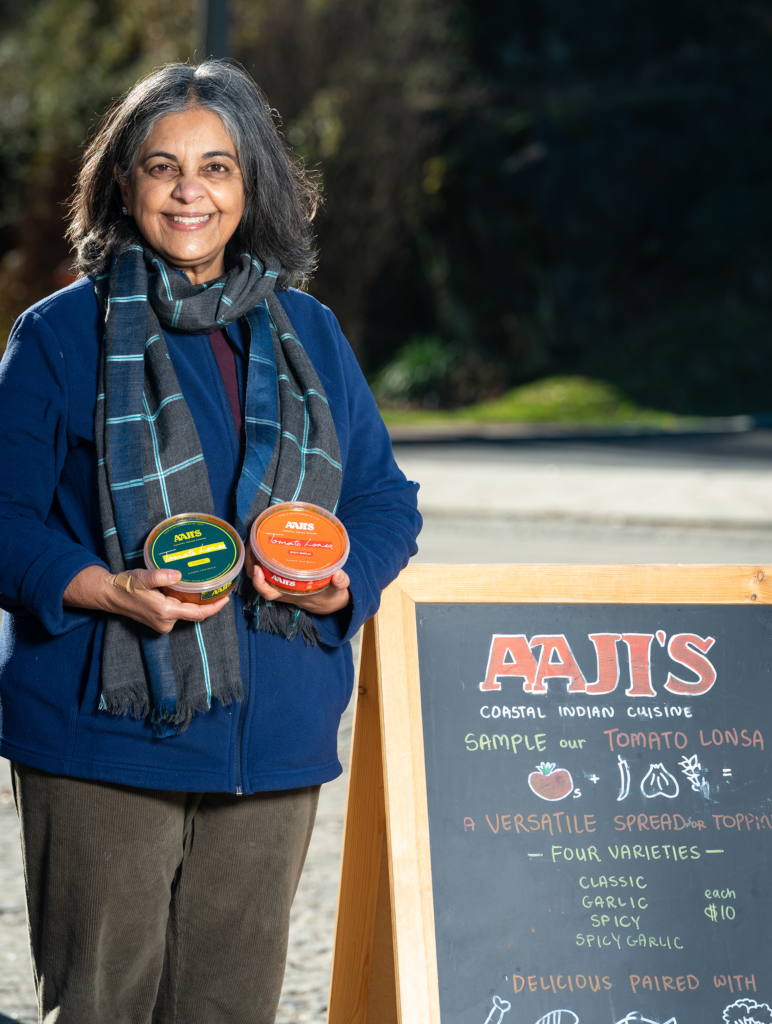

One part of the solution would be to make it inconvenient to drive to the city. and to put up gates where only pedestrians and cyclists can go through.
Fines should not be a maximum of 2000, there should be a minimum of 2000, and no real max. It should be possible to take someones license for illegal dumping. We need real serious consequences. But also we need to make it inconvenient to even come here to dump.